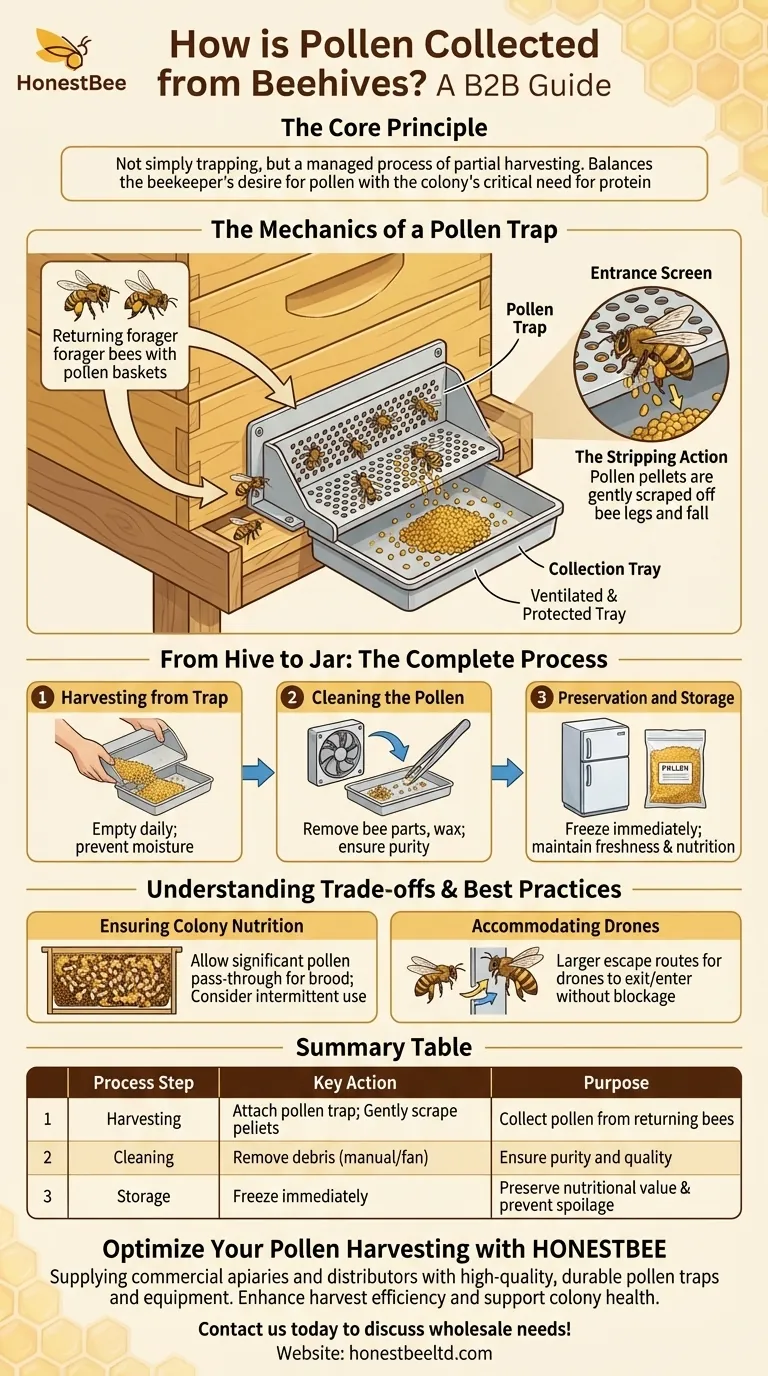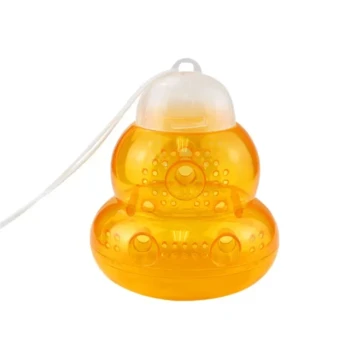Bee pollen is collected using a specialized device called a pollen trap, which is fitted to the entrance of a beehive. As returning forager bees enter, they must pass through a mesh screen with small openings. These openings are just large enough for the bee but small enough to gently scrape the pollen pellets from the baskets on their hind legs, which then fall into a protected collection tray below.
The core principle of pollen collection is not simply trapping, but a managed process of partial harvesting. A well-designed trap balances the beekeeper's desire for pollen with the colony's critical need for this protein source to feed its young.

The Mechanics of a Pollen Trap
A pollen trap is a simple yet effective device that integrates directly with the daily activity of the hive. Understanding its components reveals how it works without harming the bees.
The Entrance Screen
The heart of the trap is a screen or grid with carefully sized holes. These perforations are designed to be slightly restrictive for a pollen-laden forager bee.
As the bee squeezes through, the edges of the hole catch the compacted pollen pellets on her legs, causing them to fall away.
The Stripping Action
This process is entirely passive. The bee's own forward momentum and effort to enter the hive provides the force needed to dislodge the pollen.
The bee herself is unharmed and proceeds into the hive to deposit any remaining pollen or nectar she may be carrying.
The Collection Tray
Directly beneath the entrance screen is a collection tray or drawer. This tray catches the dislodged pollen pellets as they fall.
It is typically ventilated to prevent moisture buildup and screened to keep the bees from accessing and retrieving the collected pollen.
From Hive to Jar: The Complete Process
Collecting pollen involves more than just attaching a trap. Proper handling after harvesting is critical to ensure a clean and well-preserved final product.
Step 1: Harvesting from the Trap
The collection tray must be emptied regularly, often daily, especially in humid weather. This prevents the pollen from absorbing moisture, molding, or spoiling.
Step 2: Cleaning the Pollen
The raw harvest will contain impurities like bee parts, wax, or small bits of debris. Cleaning is essential.
For small batches, this can be done manually by spreading the pollen on a flat tray and removing foreign material with tweezers. For larger amounts, a fan can be used to blow away lighter debris, a technique similar to cleaning seeds.
Step 3: Preservation and Storage
Once cleaned, bee pollen is highly perishable. The most common and effective method of preservation is to freeze it immediately.
Freezing maintains the pollen's freshness, nutritional value, and flavor until it is ready to be packaged or used.
Understanding the Trade-offs
Using a pollen trap requires a commitment to responsible hive management. The beekeeper must balance the desire for a harvest with the fundamental needs of the colony.
Ensuring Colony Nutrition
A trap should never be 100% efficient. It must allow a significant portion of the bees to pass through with their pollen loads intact.
This incoming pollen is vital for feeding the hive's brood (young bees). Starving the colony of this protein source can severely weaken it. Many beekeepers only keep traps on for part of the day or on alternating days.
Accommodating Drones
Male bees, or drones, are larger than female worker bees and cannot fit through the small holes of the pollen screen.
A well-designed trap includes larger, secondary escape routes that allow drones to exit and enter the hive without being blocked.
Making the Right Choice for Your Goal
How you approach pollen collection should be determined by your primary objective as a beekeeper.
- If your primary focus is maximizing harvest: You will need a consistent schedule of collecting, cleaning, and freezing the pollen daily during a strong nectar flow.
- If your primary focus is hive health with a supplemental harvest: Use the pollen trap intermittently, ensuring you leave ample periods for the bees to forage without interruption.
Ultimately, successful pollen harvesting is an act of partnership that prioritizes the long-term health of the colony.
Summary Table:
| Process Step | Key Action | Purpose |
|---|---|---|
| Harvesting | Attach pollen trap to hive entrance. | Gently scrape pollen pellets from returning bees. |
| Cleaning | Remove debris (bee parts, wax) manually or with a fan. | Ensure purity and quality of the final product. |
| Storage | Freeze cleaned pollen immediately. | Preserve nutritional value and prevent spoilage. |
Ready to optimize your pollen harvesting? HONESTBEE supplies commercial apiaries and beekeeping equipment distributors with high-quality, durable pollen traps and other essential beekeeping supplies through our wholesale-focused operations. Enhance your harvest efficiency and support colony health with our reliable equipment. Contact us today to discuss your needs and place a wholesale order!
Visual Guide

Related Products
- Removable Plastic Pollen Trap With Ventilated Tray for Bees Pollen Collector
- 30 cm Plastic Entrance Hole Bee Pollen Trap and Collector
- Plastic Bee Pollen Trap Strips Comb Catcher Collector
- HONESTBEE Professional Long Handled Hive Tool with Precision Cutting Blade
- HONESTBEE Advanced Ergonomic Stainless Steel Hive Tool for Beekeeping
People Also Ask
- What are important considerations for responsible pollen collection? Sustain Your Hive's Health & Harvest
- What are the key features of a well-designed pollen trap? Optimize Harvest & Hive Health
- What are the different types of pollen traps available? A Guide to Front-Porch & Bottom-Mounted Designs
- How do bees adjust to a new pollen trap entrance? Ensure a Smooth Transition for Your Hive
- What are the main uses of bee-collected pollen? A Guide for Apiary Management and Product Sales



















